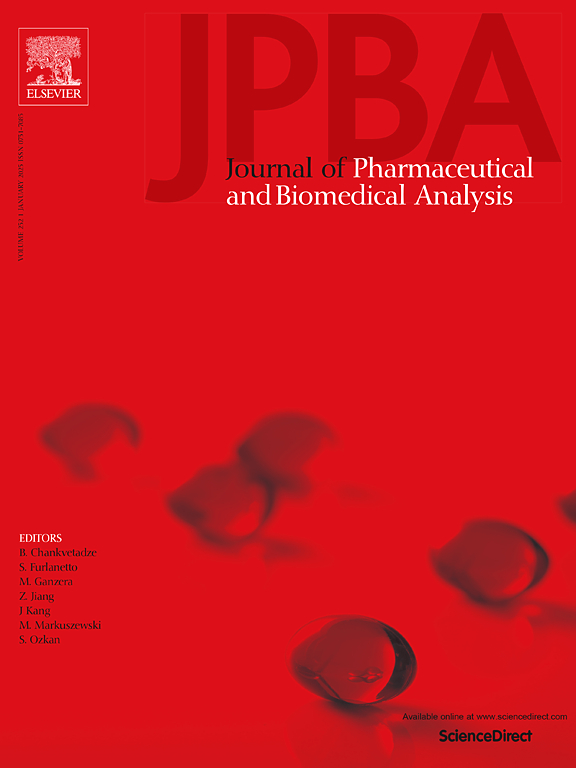多组学分析显示,经典汤通过调节色氨酸代谢、肠道菌群稳态和线粒体Bax/Bcl-2途径缓解溃疡性结肠炎
IF 3.1
3区 医学
Q2 CHEMISTRY, ANALYTICAL
Journal of pharmaceutical and biomedical analysis
Pub Date : 2025-05-19
DOI:10.1016/j.jpba.2025.116972
引用次数: 0
摘要
葛根芩连汤(GQD)是《伤寒论》记载的经典汤剂,临床用于治疗溃疡性结肠炎。然而,GQD在UC中的有效成分和潜在的药理机制仍未得到充分的探讨。在此,我们鉴定了GQD治疗UC的有效成分并阐明了其潜在的药理学机制。采用葡聚糖硫酸钠(DSS)诱导小鼠UC模型,并分别给予低、中、高剂量GQD处理。通过监测体重、疾病活动指数(DAI)、结肠长度、脾脏指数、病理变化和细胞因子水平来评估治疗效果。采用基于超高效液相色谱-四极-轨道rap质谱(UPLC-Q-Orbitrap MS)的代谢组学方法分析血浆生物标志物。肠道菌群的变化也被检查以确定参与肠道病理转变的关键微生物。此外,通过网络药理学分析预测GQD在UC中的潜在途径,随后通过western blotting和ELISA检测验证。GQD显著改善UC症状。共鉴定出98种化学成分。其中,在正常小鼠和UC小鼠之间发现了25种不同的代谢物,GQD调节其中的22种代谢物。与色氨酸、精氨酸和脯氨酸相关的代谢途径正常化。网络药理学预测凋亡途径是GQD在UC干预中的潜在靶点。进一步实验证实,GQD可降低促炎细胞因子(TNF-α、IL-6、IL-1β),下调Bax/Bcl-2凋亡通路。此外,肠道菌群分析显示,GQD提高了有益菌的多样性和丰度。GQD通过调节色氨酸、精氨酸和脯氨酸代谢,维持肠道菌群平衡,减少肠细胞凋亡来缓解UC。本文章由计算机程序翻译,如有差异,请以英文原文为准。
Multi-omics analysis reveals classic decoction alleviates ulcerative colitis by modulating tryptophan metabolism, gut microbiota homeostasis, and mitochondrial Bax/Bcl-2 pathways
Gegen Qinlian Decoction (GQD), a classic decoction documented in the Treatise on Febrile Diseases, is clinically used to treat ulcerative colitis (UC). However, the active components and underlying pharmacological mechanisms of GQD in UC remain inadequately explored. Herein, we identify the active components and elucidate the underlying pharmacological mechanisms of GQD in the treatment of UC. A mouse model of UC was induced using dextran sulfate sodium (DSS) and treated with low, medium, and high doses of GQD. The therapeutic effects were assessed by monitoring body weight, disease activity index (DAI), colon length, spleen index, pathological changes, and cytokine levels. Plasma biomarkers were analyzed using Ultra-Performance Liquid Chromatography Quadrupole-Orbitrap mass spectrometer (UPLC-Q-Orbitrap MS)-based metabolomics. Changes in gut microbiota were also examined to identify key microbes involved in the intestinal pathological shifts. Additionally, network pharmacology analysis was conducted to predict the potential pathways of GQD in UC, which were subsequently validated by western blotting and ELISA assays. GQD significantly improved UC symptoms.A total of 98 chemical constituents in GQD were identified. Of these, 25 differential metabolites were found between normal and UC mice, with GQD modulating 22 of these metabolites. Metabolic pathways related to tryptophan, arginine, and proline were normalized. Network pharmacology predicted the apoptosis pathway as a potential target for GQD in UC intervention. Further experiments confirmed that GQD reduced pro-inflammatory cytokines (TNF-α, IL-6, IL-1β) and downregulated the Bax/Bcl-2 apoptosis pathway. Moreover, gut microbiota analysis showed that GQD enhanced the diversity and abundance of beneficial bacteria. GQD alleviates UC by modulating tryptophan, arginine, and proline metabolism, maintaining gut microbiota balance, and reducing apoptosis in intestinal cells.
求助全文
通过发布文献求助,成功后即可免费获取论文全文。
去求助
来源期刊
CiteScore
6.70
自引率
5.90%
发文量
588
审稿时长
37 days
期刊介绍:
This journal is an international medium directed towards the needs of academic, clinical, government and industrial analysis by publishing original research reports and critical reviews on pharmaceutical and biomedical analysis. It covers the interdisciplinary aspects of analysis in the pharmaceutical, biomedical and clinical sciences, including developments in analytical methodology, instrumentation, computation and interpretation. Submissions on novel applications focusing on drug purity and stability studies, pharmacokinetics, therapeutic monitoring, metabolic profiling; drug-related aspects of analytical biochemistry and forensic toxicology; quality assurance in the pharmaceutical industry are also welcome.
Studies from areas of well established and poorly selective methods, such as UV-VIS spectrophotometry (including derivative and multi-wavelength measurements), basic electroanalytical (potentiometric, polarographic and voltammetric) methods, fluorimetry, flow-injection analysis, etc. are accepted for publication in exceptional cases only, if a unique and substantial advantage over presently known systems is demonstrated. The same applies to the assay of simple drug formulations by any kind of methods and the determination of drugs in biological samples based merely on spiked samples. Drug purity/stability studies should contain information on the structure elucidation of the impurities/degradants.

 求助内容:
求助内容: 应助结果提醒方式:
应助结果提醒方式:


